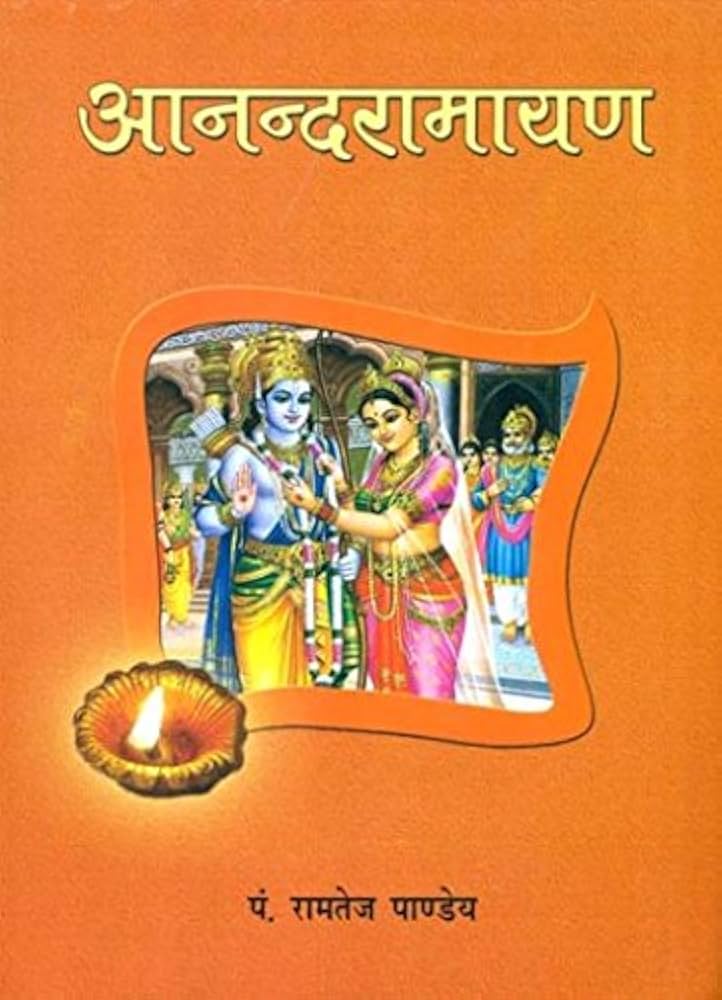Author: Unknown
About the author:
Anand Ramayan : आनंद रामायण
Anand Ramayan: A Comprehensive Overview of its Structure and Spiritual Essence
The Anand Ramayan is a hidden jewel in the vast landscape of Ramayana literature, often overshadowed by its more famous counterparts like Valmiki Ramayana and Ramcharitmanas. However, its spiritual depth and unique retellings make it a significant text for devotees and scholars alike. Written in Sanskrit, Anand Ramayan is attributed to Sage Valmiki, though its authorship remains a subject of scholarly debate. What makes this text unique is its emphasis on “Anand”—or bliss—hence its title, which reflects the transcendental joy found in devotion to Lord Rama.
Unlike other versions of the Ramayana, Anand Ramayan adds new dimensions to Lord Rama’s story, introducing additional episodes, dialogues, and events that aren’t found in traditional texts. It’s a unique blend of narrative and devotion, focusing not only on Rama’s life as a prince and warrior but also highlighting the divine bliss that comes from surrendering to his grace.
Structure of Anand Ramayan:
The Anand Ramayan is divided into seven books, each providing unique insights and stories that expand upon the core Ramayana narrative. Here’s a high-level overview of each book:
- Saar Kand (The Book of Summary)
This section begins with the cosmic origins of Lord Rama. It details the divine manifestation of Lord Vishnu as Rama, emphasizing his purpose in the world as the protector of dharma (righteousness). The Saar Kand narrates how the gods, troubled by the rise of evil forces like Ravana, request Vishnu to incarnate on earth. This book sets the foundation for Rama’s divine journey, focusing on his cosmic mission beyond just being a human prince. Surprisingly unlike other Ramayanas, this kaand has all the basic stories of Shri Ram till Ram Rajya. - Yatra Kand (The Book of Delight)
True to its name, the Manohar Kand focuses on the journey (Tirtha Yatra) of Rama’s life. - Yaag Kand (The Book of Yagya)
This book explores the various yagyas (rituals) performed by Shri Ram. - Vilaas Kand (The Book of Enjoyment)
This has Ramstavraj, Deh Ramayan and some other rare stories. This kaand has a section called Deh Ramayan where a symbolic, Vedantic and philosophical analogy of Ramayan has been expounded. Some people take that explanation literally and try to misguide others saying that Ramayan is merely a symbolic story and far from truth. This view has been refuted in this video of mine – - Janm Kand (The Book of Birth)
Stories about birth of Lava and Kusha. - Vivaah Kand (The Book of Divine Marriage)
This section has stories about marriage of Lava and Kusha. - Rajya Kand (The Book of Kingship)
It is divided in two parts – purvardha and uttarardha. - Manohar Kand (The Book of Delight)
- Poorn Kand (The Book of Completion)
Key Features of Anand Ramayan:
- Additional Stories and Episodes: The Anand Ramayan contains several unique stories and episodes that are absent in other versions of the Ramayana. For example, it elaborates on the early life of Lord Rama in greater detail, including more playful and divine manifestations during his childhood.
- Focus on Devotional Joy (Ananda): While the Valmiki Ramayana emphasizes the heroic and dharmic aspects of Rama’s life, the Anand Ramayan focuses on the joy that comes from devotion to Lord Rama. The spiritual bliss of bhakti (devotion) is a central theme, making it a beloved text for devotees seeking a deeper emotional and spiritual connection with the divine.
- Philosophical Discourses: The Anand Ramayan not only narrates the events of Lord Rama’s life but also includes profound philosophical teachings on the nature of reality, the role of devotion, and the path to liberation. It serves as both a narrative text and a spiritual guide, offering wisdom for those walking the path of dharma and bhakti.
Conclusion:
The Anand Ramayan stands out as a remarkable retelling of the Ramayana, one that blends narrative, devotion, and philosophy in a unique way. Its focus on divine bliss and the additional stories it presents make it an essential read for those seeking to deepen their understanding of Lord Rama and the path of devotion. Whether you are a scholar, a devotee, or someone interested in exploring new dimensions of Ramayana literature, Anand Ramayan offers a treasure trove of spiritual insights and joyful devotion that is waiting to be discovered.
Hindi Translation
There is only one major Hindi Translation available in PDF format. However, there have been several research papers on the subject, and I am sharing some of them as well.
Anand Ramayan|
आनंद रामायण:
लेखक : Unklnown | अज्ञात Book Language हिंदी | Hindi पुस्तक का साइज़ : - Anand Ramayan – 294 MB
कुल पृष्ठ : - Anand Ramayan – 811 pages
श्रेणी : धार्मिक / Religious, साहित्य / Literature, हिंदू – Hinduism Anand Ramayan
Research Papers (PhD Thesis)
Quite a few people have done extensive research on Anand Ramayan. Many of them are available on the Shodhganga website. Research scholars are encouraged to visit that site. I am providing some Phd Thesis here as well.
Adhyatm Ramayan Evam Anand Ramayan ka Tulnatmak Adhyayan – Ashok Kumar Verma (Allahabad Uni) (2019) – Thesis
Anand Ramayan Ek Adhyayan – Suman Devi, 387p (2021) – Thesis
Anand Ramayan Ka Sahityik Evm Darshanik Anusheelan – Sangeeta Bhadauriya (2022) – Thesis
Anand Ramayan Ke Bhagvannaamo Ka Tattvik Vishleshan – Pushpa Devi (2013) – Thesis
Anand Ramayan Ke Samajik Darshan Ka Sameekshatmak Anusheelan – Vijay Shanker Tripathi – Thesis
Anand Ramayan Me Varnit Stri Patro Ke Shaikshanik Evm Dharmik Yogdan – (2023) – Thesis
Vaalmiki Ramayan Evam Aanand Ramayan Ke Paathro ke Charitr Chitran Ka Samikshamak Addyayan – Anuj Kumar Nirmal (Allahabad Uni) (2020) – Thesis
Valmiki Ramayan Evm Anand Ramayan Ke Patron Ke Charitr Chitran Ka Samikshatmak Adhyayan – (2005) – Thesis
Valmiki, Adhyatm Tatha Anand Ramayan Me Sita – Kaushalya Devi, 409p (2012) -Thesis
- Saar Kand (The Book of Summary)






